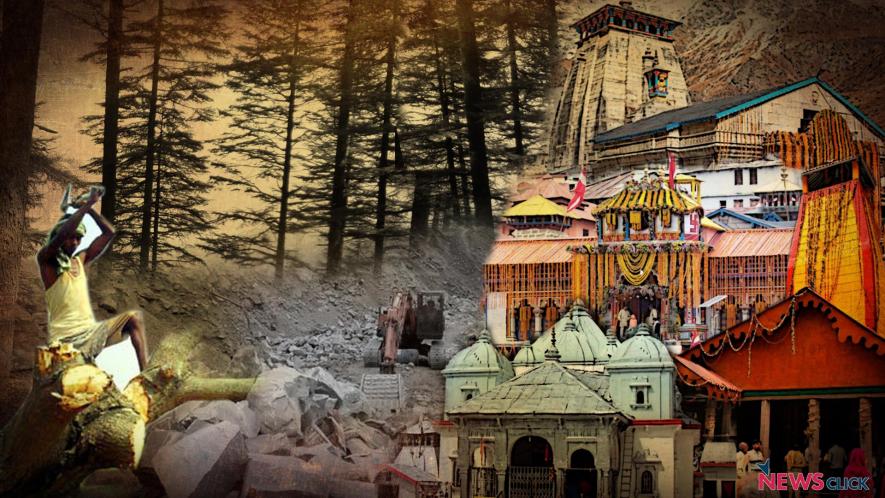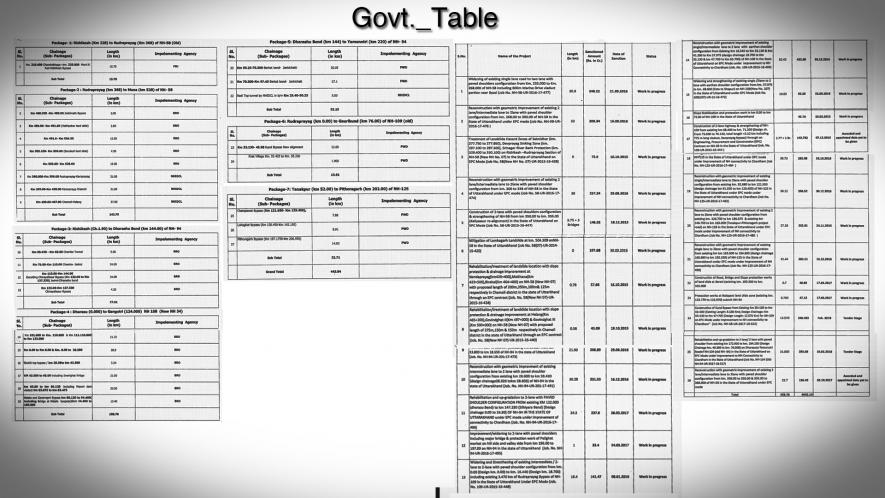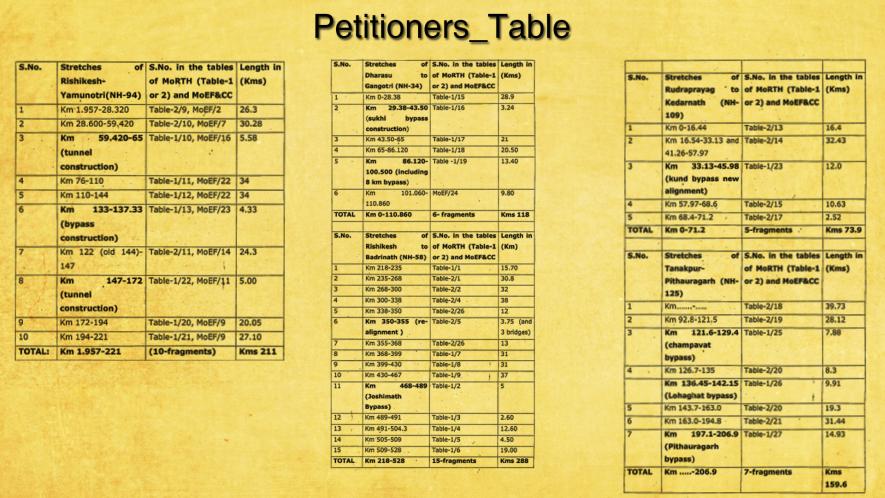Uttarakhand’s Chardham Project, a Saga of ‘Untruths’, ‘Blatant Lies’ and Ecological ‘Fraud’?

Newsclick Image by Sumit Kumar
The Ministry of Road Transport and Highways (MoRTH), Government of India, has allegedly tried to “mislead” the National Green Tribunal (NGT) based on “untruths” and “blatant lies” in the case against the Chardham project in Uttarakhand that will adversely impact the fragile ecology of the hilly state, allege environmentalists who have challenged the project in the National Green Tribunal (NGT).
The ‘Chardham Mahamarg Vikas Pariyojna’ or Chardham project – a pet project of the Modi government in the Centre – aims to connect the four pilgrimage sites of Yamunotri, Gangotri, Kedarnath and Badrinath. But, the petitioners are alleging that it is in complete violation of the Forest (Conservation) Act, 1980 and the Environment Impact Assesment Notification, 2006. They allege that the Rs 12000-crore project involves felling of over 25,000 trees and illegal dumping of debris into rivers that will cause serious destruction of fragile mountains and ecosystems. They say dumping of debris into rivers is dangerous, as it can create temporary dams storing huge amount of water.
The matter has reached the NGT after an organisation called Citizens for Green Doon and others petitioned against the project in the green body, which has reserved its final order on the project.
Interestingly, the Ministry of Environment and Forests (MoEF) “shrugged off” its responsibility despite “mounting evidence” of massive ecological destruction along several Chardham expansion routes. The green ministry earlier told the NGT that none of the segments of the 900-km Chardham project require environment impact assessment (EIA) because all of the 53 roads in the project are of length less than 100 km.
The petitioners have tried to prove in the Tribunal that the project entails five major stretches of over 100 km each to be, in fact, continuous stretches of more than 100 km.
Newsclick accessed paragraph-wise reply of the MoRTH’s affidavit filed in the NGT in support of the project from the petitioners, including environmental activist Hemant Dhyani of the Ganga Ahvaan – a movement for the conservation of the Ganga and the Himalayas.
The MoRTH – in its affidavit – reiterated its stand that stretches up to 100 km are exempted from environmental clearance by law, and so long as the work is within 100 km, there is protection and the work is allowed to be carried out. In support of its argument, the ministry broke up one continuous stretch of the national highway into 15 different segments randomly in a table.

Objecting to the submission, the petitioners said that the road ministry has stated“incorrect” facts. They said the works are, in fact, continuous and form one uninterrupted, unbroken stretch of NH-58 totalling 288 km from Rishikesh to Badrinath. “Same is the case in all the main stretches from Rishikesh to Yamunotri, Dharasu to Gangotri, Rishikesh to Kedarnath, Tanakpur to Pithoragarh,” they said adding that “just by breaking up one continuous stretch of the national highway into 15 different segments does not in any way mean that these are separate work projects”.
The petitoners have also prepared a table – which they have submitted with their reply to the ministry’s affidavit in the tribunal – a complete connectivity and of these five major stretches of national highways. As per the table, all 54 separate proposals of the government are in fact continuous stretches of five national highways – (i) Rishikesh to Yamunotri (240 km), (ii) Dharasu to Gangotri (124 km), (iii) Rishikesh to Kedarnath (216 km), (iv) Rudraprayag to Badrinath (160 km) and (v) Tanakpur to Pithauragarh (150 km).

Furthermore, they said, the small breaks of few metre to few kilometres are no real breaks but sections of tunnelling, landslides or bypass construction on the opposite slopes. “To distort the truth that a stretch is not continuous because of its minor breaks is a gross falsification and in absolute disregard of honesty and scientific verity,” they alleged.
The ministry said in its rejoinder that it has submitted that there are several stretches where works are undertaken, the total number of stretches/projects are 53. None of them can be said to be one particular stretch of length more than 100 km. It said, at times, the distance between two stretches is more than 100 km and even up to 200 km.
The petitioners dubbed the ministry’s submission that the distance between two stretches is 100-200 “absolutely false and untrue”. “We are shocked by this blatant untruth. The table submitted by the respondent itself clearly shows this. Moreover, a three dimensional view of these five adjoining parallel valleys reveals the close proximity,” they added.
According to the government, some of the works involve widening of existing single lane roads to two-lane roads and some involve geometric improvement of existing intermediate lanes. Each of these works – which are around 26 contracts – do not exceed 100 km at all.
To this, the petitoners state the government once again is giving “false information and trying to mislead the NGT. “In reality, one can clearly see the entire mountain slopes excavated up to 30 meter width; whereas, for two lanes, only 8.8 meters are required. Thus, much unnecessarily tow cutting of slopes, tree felling has already happened. This can be observed in the already existing two-lane stretches like Muni ki Reti to Agrakhal, Rishikesh to Devprayag, Devprayag to Srinagar etc.,” they argued.
The ministry perhaps forgot the fact the stipulated minimum of 100 km stretch of national highway for environmental clearance is applicable only to the plains and flat regions, where there are no mountain base cutting and landslide zones.
ALSO READ: Government Divides 900 Km Long Chardham Project Into 52 Parts to Bypass Environmental Clearances
Why a law which was made for the plain areas cannot be accepted for the fragile hilly terrain? This criteria – according to the petitioners – is not practical for hills due to following reasons: (i) in plain areas, the expansion of highways goes up to six or eight lanes with larger width. But in the hills, the expansion can be done only up to two lanes with smaller width which goes up to maximum 8.8 metre. Therefore, the criteria of 40 metre right of the way is not practical here at all. (ii) In hilly areas, there is a major addition of work where expansion needs cutting/excavation of mountain slopes thereby generating a huge amount of muck and dumping into the river side hill slopes, which in plain areas does not take place. (iii) In hills, destabilisation of mountains and thereby triggering the landslides impact on water springs and impacts on micro-climate are additional factors than the plain areas. (iv) Among all the other hills, Himalayan hills are most fragile and sensitive. Hence, this criteria (100 km length, 40 meter right of way) cannot be considered as practical for hills and specially for this fragile and sensitive terrain of Chardham in Himalayas.
“Taking advantage of the lacuna in rules for hill road construction, that too by fraudulent means, is ethically unacceptable to the citizens of this country. In the mountains, where one valley adjoins the others, geographically and topographically, these five major stretches will be seen to be contiguous, in close proximity, having an aerial distance of merely 10-20 kilometres separating them. Hence, the environmental damage would be cumulative in these parallel valleys. To ignore this vital fact would be a geological and environmental fraud,” said the petitioners.
The ministry further told the NGT these projects were awarded in the years 2015, 2016, 2017, and all of which have reached advance stage of progress/completion. “The Government of India has spent around Rs 900 crores on all these works so far. These are all work undertaken in public interest,” the ministry submitted.
Terming the argument another attempt to misguide the NGT, the petitioners said the “proposals of all forest clearances is given by the Ministry of Environment, Forest and Climate Change (MoEF&CC), which is a self-evident proof that all the 24 forest clearances were granted in the end of 2017 and beginning of 2018. Hence, the submission of the MoRHT that projects were awarded in the years 2015, 2016, 2017 and all of which have reached advanced stage of progress/completion is contrary to the proofs submitted by the MoEF. Moreover, most of the roads along the Chardham route are already double laned (7-8 metres) and are now being widened in complete violation of the existing guidelines for hill roads, since at many stretches, the road has been cut to 15 to even 30 metres. Further, the project also includes by-passes and new alignments that have been proposed through pristine forest stretches, all of which has been brushed under the larger heading of ‘geometric improvement’,” the petitioners said.
Defending its project, the ministry told the NGT, “It is indeed important to note that large number of people travel to these areas. In the unfortunate incident, which took place in 2013, large number of people died due to no road connectivity and washing away of existing roads. These areas cannot be left unattended. They are to be refurbished and re-done for the purpose of facilitating pilgrimage travel also for strategic points for the defense purposes having regard to the international border with China. This is very important and one cannot lose sight of the same as this is a primary interest of the nation.”
In response to this, the petitioners said, “In June-2013 disaster, roads were destroyed due to erosion by flooded water or by landslides. This blanket widening of the existing roads would not help at all in case of danger from the river side erosion and in fact it would make the hills more prone to landslides. Moreover, the government has the list of strategic roads i.e. Indo-China-Border-Roads (ICBRs), which are identified and marked by the government itself and none of the segment proposed falls in the category of ICBR. The ministry is again making misleading statements.”
Get the latest reports & analysis with people's perspective on Protests, movements & deep analytical videos, discussions of the current affairs in your Telegram app. Subscribe to NewsClick's Telegram channel & get Real-Time updates on stories, as they get published on our website.
























